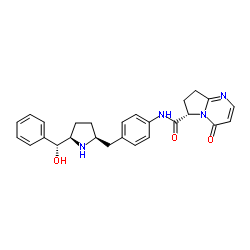1190389-15-1
| Name | Vibegron |
|---|---|
| Synonyms |
M5TSE03W5U
Pyrrolo[1,2-a]pyrimidine-6-carboxamide, 4,6,7,8-tetrahydro-N-[4-[[(2S,5R)-5-[(R)-hydroxyphenylmethyl]-2-pyrrolidinyl]methyl]phenyl]-4-oxo-, (6S)- (6S)-N-[4-({(2S,5R)-5-[(R)-Hydroxy(phenyl)methyl]-2-pyrrolidinyl}methyl)phenyl]-4-oxo-4,6,7,8-tetrahydropyrrolo[1,2-a]pyrimidine-6-carboxamide Vibegron |
| Description | Vibegron (MK-4618) is a potent, highly selective β3-adrenoceptor agonist (EC50=1.1 nM). Vibegron can be used for severe urgency urinary incontinence related to overactive bladder[1][2][3]. |
|---|---|
| Related Catalog | |
| Target |
β3 adrenoceptor:1.1 nM (EC50) |
| In Vivo | Vibegron (1~12 μΜ; i.v.) exhibits dose dependent decreases in micturition pressure and increases in functional bladder capacity[3]. Vibegron (30 mg/kg; p.o.; 4 weeks) upregulates mRNA levels of type 1, type 3 collagen, TGF‐β1, and HIF‐1α[4]. Vibegron (1 and 10 mg/kg; i.v.; interval 30 minutes) (10 mg/kg) in oxo-M-treated rats makes bladder capacity significantly decreased compared with oxo-M-not treated rats (intravesical instillation of vehicle)[5]. Animal Model: Rat Dosage: 1~12 μΜ Administration: I.v. Result: Exhibited dose dependent decreases in micturition pressure and increases in functional bladder capacity. Animal Model: Female C57BL/6N mice (9 weeks old) Dosage: 30 mg/kg Administration: P.o.; 4 weeks Result: Upregulated mRNA levels of type 1, type 3 collagen, TGF‐β1, and HIF‐1α at 4 weeks. Animal Model: Female F344 rats (120–160 g) Dosage: 1 and 10 mg/kg Administration: I.v.; Interval 30 minutes Result: Vibegron (10 mg/kg) in oxo-M-treated rats made bladder capacity significantly decreased compared with oxo-M-not treated rats (intravesical instillation of vehicle). |
| References |
| Density | 1.4±0.1 g/cm3 |
|---|---|
| Molecular Formula | C26H28N4O3 |
| Molecular Weight | 444.526 |
| Exact Mass | 444.216156 |
| LogP | 0.66 |
| Index of Refraction | 1.698 |
